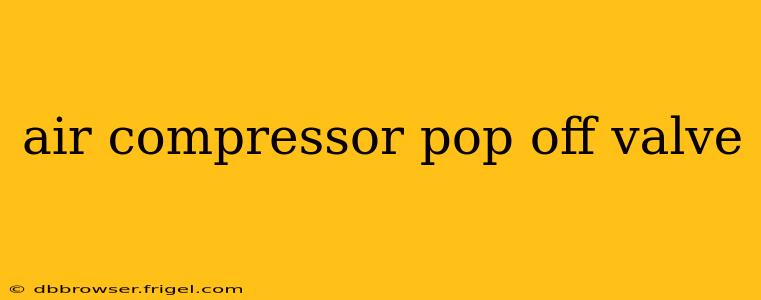An air compressor pop-off valve, also known as a pressure relief valve or safety valve, is a critical safety component preventing dangerous pressure buildup within the tank. This guide delves into the intricacies of this vital part, addressing common questions and concerns.
What is an Air Compressor Pop-Off Valve?
The air compressor pop-off valve is a pressure-activated release mechanism designed to automatically vent compressed air when the tank pressure exceeds a predetermined safe limit. This prevents the tank from rupturing, a potentially catastrophic event. It's a crucial safety feature ensuring the safe operation of your air compressor. Think of it as a pressure safety net for your entire system.
How Does an Air Compressor Pop-Off Valve Work?
The valve typically consists of a spring-loaded mechanism and a valve seat. When the tank pressure reaches the valve's preset limit, the pressure overcomes the spring's resistance, forcing the valve open and releasing compressed air. Once the pressure drops below the set point, the spring closes the valve, stopping the air release. The precise mechanism might vary slightly depending on the manufacturer and valve type, but the underlying principle remains consistent: preventing over-pressurization.
What Happens if the Pop-Off Valve Fails?
A malfunctioning pop-off valve is a serious safety hazard. If the valve fails to open at the correct pressure, the tank pressure can continue to rise, potentially leading to a tank rupture with explosive force. This could result in serious injury or property damage. Regular inspection and maintenance are paramount.
How Often Should I Check My Air Compressor Pop-Off Valve?
Regular inspection is key to ensuring the safety and longevity of your air compressor. It's recommended to visually inspect your pop-off valve before each use, checking for any signs of damage, leaks, or unusual wear. You should also periodically test its functionality (see below for instructions). The frequency of this testing depends on the compressor's usage – more frequent testing is warranted for heavy-duty or frequent use.
How Do I Test My Air Compressor Pop-Off Valve?
Testing your pop-off valve is crucial for ensuring its proper functioning. Never attempt to test the valve by exceeding the manufacturer's recommended pressure. Instead, carefully observe the valve during normal operation. Listen for any unusual hissing sounds which could indicate a leak. You can also gently tap the valve to check for any looseness or signs of damage. If you suspect a malfunction, consult your owner's manual or a qualified technician. Many manuals will detail a more specific testing procedure.
Can I Replace My Air Compressor Pop-Off Valve Myself?
Replacing a pop-off valve is often a relatively straightforward task, but it requires some mechanical aptitude. It's important to choose a replacement valve with the correct pressure rating for your specific air compressor model. Always consult your owner's manual for specific instructions and safety precautions. If you're unsure, it's best to consult a qualified technician to avoid potential damage or injury.
What are the Signs of a Bad Air Compressor Pop-Off Valve?
Several indicators can signal a problem with your pop-off valve. These include:
- The valve is leaking: A constant hissing sound indicates a leak, even when the compressor is not running.
- The valve is stuck open: This will result in a continuous loss of air pressure.
- The valve is stuck closed: This is the most dangerous scenario, as it allows pressure to build beyond safe limits.
- Visible damage: Any cracks, dents, or other visible damage to the valve warrants immediate replacement.
Why is My Pop-Off Valve Leaking?
A leaking pop-off valve can have several causes, including:
- Wear and tear: Over time, the valve's seals and components can wear out, leading to leaks.
- Incorrect installation: Improper installation can compromise the valve's seal.
- Damaged components: A damaged spring or valve seat can cause leaks.
- Excessive pressure: Repeatedly exceeding the recommended pressure can damage the valve's internal components.
Regular maintenance, including cleaning and lubrication (if recommended by the manufacturer), can help prevent premature wear and tear. However, even with careful maintenance, valves eventually require replacement.
This comprehensive guide offers a detailed understanding of air compressor pop-off valves. Remember that safety should always be the top priority. If you have any doubts about the functionality of your valve, always err on the side of caution and consult a qualified technician.
